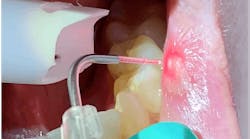Stronger bone for oral surgery created by introducing microcracks in the jawbone
Journal of Oral Implantology — Although it seems counterintuitive, a bone break can lead to a stronger bone that can support an oral implant. Introducing microcracks in the jawbone stimulates bone growth. Once greater bone density is established in the jaw, patients have an improved opportunity for successful placement of oral implants and dental prostheses.
An article in the Journal of Oral Implantology describes an approach to oral implant surgery for patients with severely atrophic jaws that stimulates bone activation of the future implant location. More complicated procedures such bone grafts and sinus lifts have met with success, but are not always desirable.
Dental patients with severely atrophic jaws have poor quality and quantity of bone in which to place an implant. Using the Osteotensor, a purpose-designed instrument, a series of microcracks are created in the jawbone. A biological response then takes place: proteins, stem cells, and other growth factors work to regenerate the bone.
After 45 to 90 days, implant surgery can take place. Solid titanium disks are implanted into the bone bed and covered by biomaterial. A rigid, screw-fixed prosthesis can then be immediately loaded and become functional.
The authors of the article report the case of a 74-year-old woman treated with this technique after she declined to undergo a bone grafting procedure. Forty-five days after microcracks induced bone activation, the same Osteotensor instrument could no longer penetrate bone at 23 of 42 impact sites. After 90 days, none of the sites could be penetrated. Softer, type IV bone had been transformed to harder, type II bone, and it was safe to proceed with implant surgery.
Two years later, the patient’s implants were osseointegrated, and the regenerated bone had become functional bone. For this patient and others who may have experienced implant loss or bone graft failure, this procedure can offer a second chance for implant success.
Full text of the article, “Fixed Rehabilitation of Severely Atrophic Jaws Using Immediately Loaded Basal Disk Implants After In Situ Bone Activation,” Journal of Oral Implantology, Vol. 38, No.5, 2012, is available here.
The Journal of Oral Implantology is the official publication of the American Academy of Implant Dentistry and of the American Academy of Implant Prosthodontics. It is dedicated to providing valuable information to general dentists, oral surgeons, prosthodontists, periodontists, scientists, clinicians, laboratory owners and technicians, manufacturers, and educators. The JOI distinguishes itself as the first and oldest journal in the world devoted exclusively to implant dentistry. For more information about the journal or society, please visit their website.





